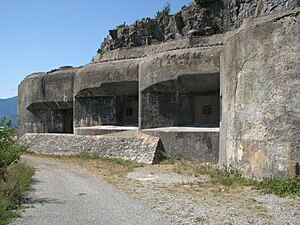Ouvrage Rimplas
| Ouvrage Rimplas | |
|---|---|
| Part of Maginot Line, Alpine Line | |
| Southeast France | |

Rimplas Block 5
|
|
| Coordinates | 44°03′36″N 7°07′42″E / 44.06005°N 7.1284°E |
| Site information | |
| Owner | General Council of the Alpes-Maritimes |
| Controlled by | France |
| Open to the public |
Yes (on occasion) |
| Site history | |
| Built | 1928 |
| Built by | CORF |
| In use | Preserved |
| Materials | Concrete, steel, rock excavation |
| Battles/wars | Italian invasion of France, Operation Dragoon |
| Ouvrage Rimplas | |
|---|---|
| Type of work: | Large artillery work (Gros ouvrage) |
|
sector └─sub-sector |
Fortified Sector of the Maritime Alps └─Vésubie, Quartier Gaudissart |
| Regiment: | 84th BAF, 167th RAP |
| Number of blocks: | 6 |
| Strength: | 8 officers, 334 men |
Ouvrage Rimplas is a work (gros ouvrage) of the Maginot Line's Alpine extension, the Alpine Line, known also as the Little Maginot Line. The ouvrage consists of one entry block, two infantry blocks and three artillery blocks at an altitude of 986 metres (3,235 ft). It was the first ouvrage of any portion of the Maginot Line to be completed, in 1928. The ouvrage features an aerial tram entrance.
Located on a height to the southwest of Rimplas, the position was originally called Ouvrage de la Madeleine. While it was a prototype for later work, it is not entirely typical of Maginot fortifications, with large expanses of wall armored with 20 cm steel plate and other sections overlaid with stone masonry. The construction encountered problems with soil consistency and water infiltration. The underground portion of the ouvrage, containing the ammunition magazines, living quarters, command spaces, generating plant and communication galleries between the combat blocks covers three levels. Rimplas stands on a prominent height above the Tinée and Valdeblore valleys before their streams join to form the river Var. It is supported by the petits ouvrages of Fressinéa and Valdeblore, all planned to control the approaches to Nice along the Var.
Work began in November 1930 and was completed in April 1934, initially performed by a contractor named Faraut and completed by Contesso, at a cost of 34.2 million francs, including 1.7 million francs for the aerial tram. The final cost was four times the initial estimate, making Rimplas the second most expensive position (after Monte Grosso) in the Alpine Line. Difficulties with the friable nature of the rock required that some rock faces be concreted or covered with masonry to stabilize them. The project went through three major design changes before completion. The ouvrage was fully equipped and operational in August 1937. In 1940 the position was commanded by Captain Toussaint.
Rimplas was accessed by a single-cable aerial tram with a length of 872 metres (2,861 ft) and a rise of 602 metres (1,975 ft), leading directly into its own entrance block. The underground galleries were unusually laid out on two levels, with ammunition on the lower level and accommodations on the upper.
...
Wikipedia

